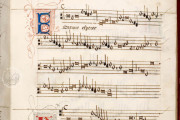The Henry VIII Book is a manuscript of polyphonic songs and instrumental music copied at the court of the English king, probably in London, between 1510 and 1513. It owes its name to the person represented by more compositions (thirty-three) than any other, Henry VIII. The manuscript was copied for someone in the king's circle, perhaps Henry Guildford (1489-1532), who was appointed comptroller of the royal household in 1522. It contains 109 pieces in a variety of genres.
The collection is dominated by pieces attributed to Henry (1491-1547), William Cornysh the Younger (d. 1523), and Thomas Farthing (d. 1520) and includes works by other contemporary English composers, as well as Continental musicians, mostly of the previous generation.
Music at the Tudor Court
The manuscript provides a fascinating glimpse into musical taste at the court of Henry VIII. The book was almost certainly created to be used in amateur music-making lack of words for many pieces or the inclusion of only an incipit (perhaps to identify the tune) suggests that the performing musicians were instrumentalists rather than singers.
Various Genres
Although the manuscript opens with a Benedictus of the Latin Mass (untexted but listed as such in the index), the repertoire is principally secular and embraces instrumental consorts, rounds (canons), carols, and songs on a variety of themes, including the hunt. Most of the pieces are three-part polyphony, but some are also for two, four, or five instruments or voices. It is unspecified how many voices should perform the rounds.
Twenty-Seven Composers
The manuscript comprises the work of twenty-seven composers. Most of the pieces, many very short, are by English composers. A dozen are by composers from farther afield and of an earlier generation: the securely attributable works include examples by Heinrich Isaac (d. 1517), Alexander Agricola (d. 1506), and Hayne van Ghizeghem.
Music in Parts
Each piece generally occupies two facing pages or—for longer works—a series of openings coordinated so that all performers could play or sing with the book spread open in front of them. Texts of subsequent verses of stanzaic pieces (songs with multiple strophes of matching patterns of rhythm and meter) follow the notated first stanza.
Four Scribes
The manuscript was almost entirely copied by a single musician writing mensural notation (indicating precise pitch and duration) on a five-line staff. The text script is quite variable, with letterforms taken from the canon of Gothic Textualis, Hybrida, and Cursiva scripts. Three more scribes added one piece each. It has been suggested that the pen-flourished initials are the work of the principal scribe.
The manuscript was owned by Thomas Fuller (1654-1734), Stephen Fuller (1716-1808), Archibald Montgomerie (1726-1796), and Charles Montolieu Lamb (1785-1860) before being purchased by the British Museum from the Lamb family in 1882. It became a part of the British Libray upon its foundation in 1973.
We have 1 facsimile edition of the manuscript "Henry VIII Book": The Henry VIII Book facsimile edition, published by DIAMM, 2014
Request Info / Price






